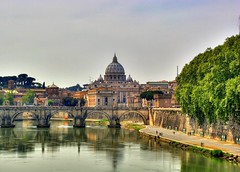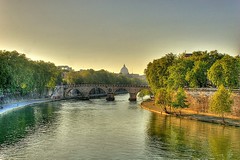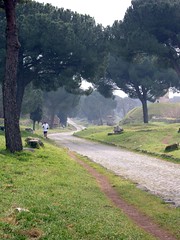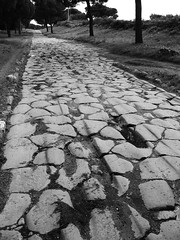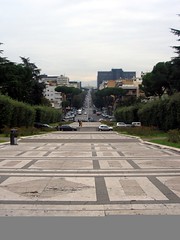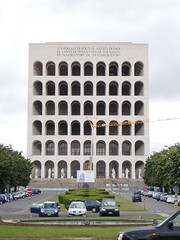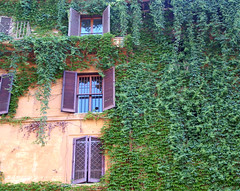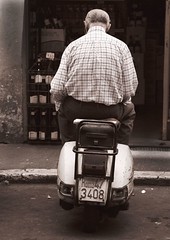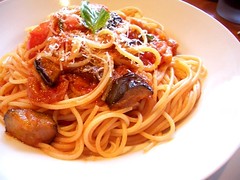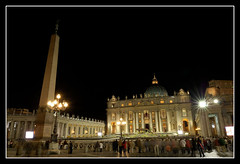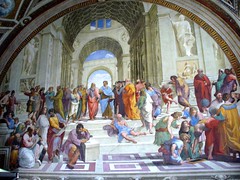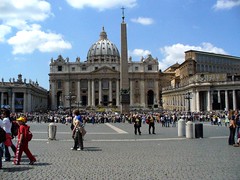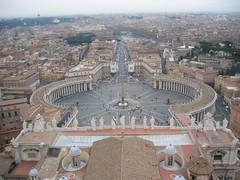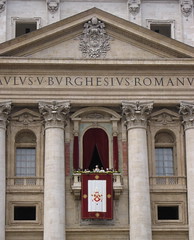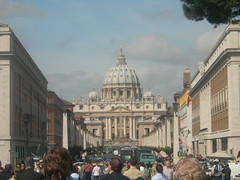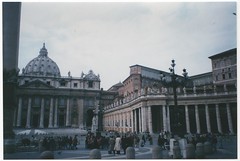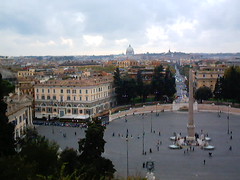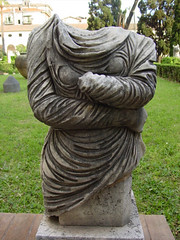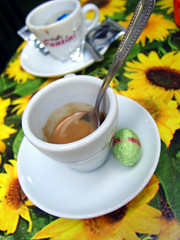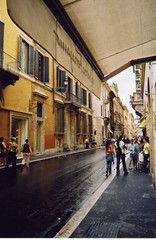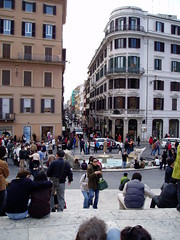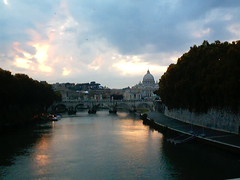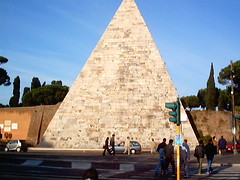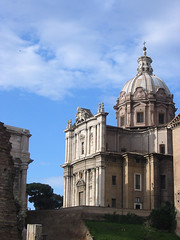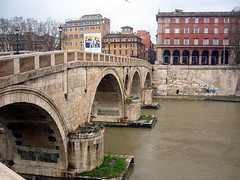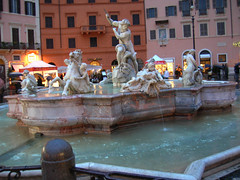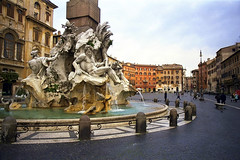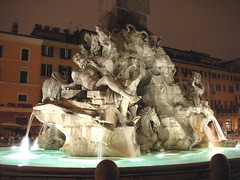A short list of the blogs I have created:
http://www.businesshackers.com
http://neuralmarkets.blogspot.com/
http://triptorome.blogspot.com/
http://triptoaarhus.blogspot.com/
Monday, December 04, 2006
Site recommendation: Businesshackers.com
The site I would like to suggest visiting has little to do with this website, but I hope you will find it useful: www.businesshackers.com
Friday, September 01, 2006
Major events in Rome... september...
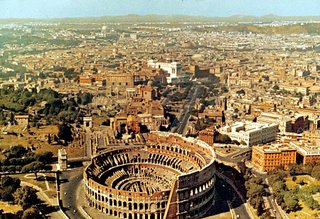
European Frisbee Freestyle Championships type: sport
This weekend sees the European Frisbee Freestyle Championship taking place at the Corallo Beach resort in Ostia (Lungomare Amerigo Vespucci, 112). The best freestylers from across Europe will compete 2 divisions; Open Pairs and Open Co-op (3 persons team). Over 50 players from Sweden, Denmark, Holland Germany, Switzerland, France and Italy will be throwing their plastic disks down on the beach. On Sunday there will also be a demonstration by some of the top American Players. The freestyle routines will be 4 or 5 minutes long and feature creative, artistic and athletic moves with flying discs choreographed to music. Entrance to the event is free, on Saturday the action begins at 9 a.m. and ends with a party complete with Frisbee freestyle shows and disco. Sunday begins at 10.30 a.m. with a cocktail party.
Corallo Beach - Lungomare Amerigo Vespucci, 112
from 02/09/2006 to 03/09/2006
I Concerti del Tempietto alla Casina delle Civette type: Concert
Casina delle Civette di Villa Torlonia
from 12/08/2006 to 03/09/2006
Concert "aspettando la notte bianca" type: Concert
8 September in Piazza di Siena 21.30 , with Pino Daniele, Elisa, Ivano Fossati and Fiorella Mannoia
Piazza di Siena
08/09/2006
COSMOPHONIES 2006 type: Concert
Teatro Romano di Ostia Antica
from 16/06/2006 to 08/09/2006
I Concerti del Tempietto al Teatro di Marcello type:
Parco Archeologico del Teatro di Marcello
from 08/06/2006 to 01/10/2006
Moonlight Station type:
Eliseo Theatre
from 01/05/2006 to 31/12/2006
Tersicore - new spaces for dance type:
In February at the Conciliazione Auditorium will start TERSICORE, event that will bring on the Roman scene the most presigious names of the contemporary choreography, as Sylvie Guillem, Pilobolus Dance Theatre, Ballet Preljocai, Merce Cunningham Dance Company, and the emerging Italian company conducted by Mvula Sungani.....
Conciliazione Auditorium (Rome) - Valle Theatre (Rome)
from 10/02/2006 to 14/01/2007
Guided Tours by night at Ara Pacis in Rome
Museo Ara Pacis - Via Lungotevere in Augusta
dal 25/07/2006 al 07/09/2006
Poetry illustrations of Goethe
On display a masterpiece of impressionist book ilustration: the lithographs for a selection of poems by Goethe on the publishing house Paul Cassirer, published in 1924-26. Artists: Andreu Alfaro, Ernst Barlach, Max Liebermann, Hans Meid, Karl Walser.
Closed Mon, h 10-18, Int 3 €, Rid 2 €
La Casa di Goethe, Via del Corso, 18
dal 09/06/2006 al 10/09/2006
Shangai Blues
The exhibition presents a rich selection of works. Watercolours which time has seen profitably used to illustrate literary works from Shakespeare to Sylvia Plath, from Derek Walcott to Su Ling. Includes the latest created in2006, to the intersecting, musical rhythm of John Cage's story. Artist: Elissa Montessori.
h 8.30 - 19 Closed Mon INT 9 €
Galleria Nazionale di Arte Moderna, via Aldovrandi, 1
dal 09/06/2006 al 10/09/2006
Galileo Chini
The exhibition includes more than 200 pieces, and celebrates this important Florentine artist 50 years since his death by following all the stages of his intense and varied activities. For the first time, we can explore his entire work in one sitting, from large-scale decorations to painting, from ceramics to glass, and to work for theatre. Closed Mon, Int 9 €
Galleria Nazionale di Arte Moderna, via Aldovrandi, 1
dal 09/06/2006 al 10/09/2006
Raffaello from Florence to Rome
Containing over 60 pieces, this exhibition investigates Raffaello Sanzio's work in the years 1505 to 1508 when he was close to moving to Rome.
During this period he painted "Desposizione" conserved at the Borghese Gallery and which laid th way for the revolutionary passing from tradiitonal structural composition to the concept of dynamic space which apperared with the Vatican Room's frescoes.
Museo di Villa Borghese - sera
dal 19/05/2006 al 10/09/2006
La Samaritana Al Pozzo
Palazzo Braschi - Museo di Roma, P.zza S. Pantaleo, 10
dal 07/07/2006 al 10/09/2006
Al Vittoriano I Paesaggi Italiani
Vittoriano
dal 02/02/2006 al 20/09/2006
The Women of Trastevere
This interesting photography exhibition illustrates life in Trastevere, one of Rome's oldest and most popular neighbourhoods, in the seventies by way of the women who lived there in that period.
Emilio Gentilini walked the cobble-stoned alleys and squares, and documented all he saw, and above all the women who made Trastevere their home, their territory.
The Museo di Roma in Trastevere (Piazza Sant'Egidio 1b) hosts the exhibition, which runs till September the 24th, and is opene from 10 a.m. till 8 p.m. (last admission at 7 p.m., from Tuesday.
Admission costs €5,50 and includes admission to the museum (concs €4).
Info: 06.52059127
Trastevere - Piazza Sant'Egidio 1b
dal 19/07/2006 al 24/09/2006
Marc Quinn and Christian Boltanski
The space hosts a large scale, site-specific installation (filling one of the gallery's 1000 square metre pavilions entirely) by the French artist, Christian Boltanski.
300 hanging items of clothing descend from ceiling, recorded voices are played from loud -speakers, historical events are projected on transparent walls, and pulsating light illuminates glass cabinets.
< Its also the first personal exhibition by one English artist to be presented in an Italian museum. It puts together over 30 pieces that have the human body as their theme:its transformations, conservation, survival and fragile beauty. One of the Young British Artists most controversial members, Marc Quinn often works with organic substances like blood, placenta, DNA and milk:elements that help increase his work's expressivity.
MACRO - Museo di Testaccio
dal 21/06/2006 al 30/09/2006
Museum Carlo Bilotti e la mostra Damien Hirst, David Salle, Jenny Saville
The Carlo Bilotti museum hosts part of the amazing collection that the magnate of the same name donated to the city. The best represented artist is De Chirico, but alongside his paintings we can find a large Giacomo Manzù cardinal bronze, and a double portrait of Bilotti's wife and daughter. There is also an exhibition of Hirst, Salle and Saville in the Bilotti Chapel. This series of large format pieces sets out to "create an exhibition space that's more mental than physical: an environment for meditation in the widest sense, than can put you in a good mood, or a bad one". Closed Mon, h 9-19 ,Int 6 €, rid 4 €
Museo Carlo Bilotti all
dal ... al 10/10/2006
Baroque Rome:Bernini, Borromini, Pietro da Cortona
An exhibition of large models of the most important Baroque works in Rome, including both those that were completed and those that remained on the drawing board. The exhibition passes from architecture to decorative arts, from music to science, and features some of the period's most important artists, such as Bernini, Baciccio, Borromini and Pietro da Cortona.
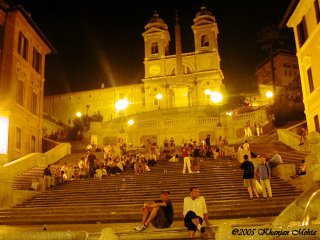
CASTEL SANT'ANGELO
dal 26/06/2006 al 29/10/2006
Henri Cartier - Bresson
Exhibition in two parts, the first containing Bresson's photographs taken in Rome during his various trips to the capital, the second a series of his portraits.
Museo di Roma - Palazzo Braschi
dal 31/05/2006 al 29/10/2006
Wednesday, August 16, 2006
Help Trip to Rome...
if you appreciate the efffort i put into this blog please link to:
http://triptorome.blogspot.com (without www)
or add this site to social bookmarks including delicious, flur, etc.
thanks for your help
http://triptorome.blogspot.com (without www)
or add this site to social bookmarks including delicious, flur, etc.
thanks for your help
Sunday, August 13, 2006
How to behave in Rome...

Italy has a reputation for being warm and welcoming. Here are some general comments on Italian culture, and some tips for adjusting to Italian manners and standards. Obviously this is mostly based on personal experiences; generalisations of course do not always hold true.
When in Rome...
Greetings
Italians greet friends with two light kisses on the cheek, first the right and then the left. Even if you're merely acquaintances, this form of greeting is usual, both on arrival and departure. When groups are splitting up, expect big delays as everyone kisses everyone else. On first introduction a handshake is usual, although not necessarily the firm businesslike shake other nationalities may be used to.
Foreign reserve
If your inbred cultural reserve makes you feel uncomfortable with this, don't worry too much. The British in particular have a reputation for being reserved, so you can always play up to this expectation, and Italians will understand you don't mean to be rude. Handshakes are also accepted greetings, and some Italians will kiss compatriots and offer their hand to the awkward Brit.
Shops
In a small-medium sized shop, it's standard to greet the staff as you enter, not when you approach the counter to pay. A friendly 'Buongiorno' or 'Buonasera' warms the atmosphere. When paying, we've found that staff usually expect you to put coins down on the surface or dish provided, rather than placing money directly into their hands (fear of germs? money-handling etiquette?), and they will do the same when giving you your change (il resto). The advent of the euro has caused problems for the Italians. Most lira transactions were in banknotes, and people are still adjusting to the fact that coins are now of significant denominations and in general use. Don't be surprised to find the whole issue of change rather perplexing for cashiers, who may try to insist you give them complex combinations of coins and notes rather than simply changing your notes.
Making friends
To make friends, it's a good idea to pay some compliments. Most Italians still live in their town of origin and feel far more strongly about their local area than they do about Italy in general. Tell them how beautiful their town/lake/village/church is - and possibly add how much you prefer it to Rome/Milan/other Italian towns. Residents can be founts of knowledge regarding their local monuments and history, and a few questions will often produce interesting stories.
Clothing
Whole essays can be written about the Italians' relationships with clothes (maybe a future addition to this site...). Three of the most important observations:
1. Italians are very conformist about clothing; everyone wears the same fashions, from teenagers to grans (this can take some getting used to... see comment 2 below). Don't be surprised or insulted if you are looked at askance for your 'eccentricity' in not wearing the latest customised jeans or fiendishly-pointed boots.
2. It's important not to judge people in return by their choice of clothing. Styles do not necessarily carry the same connotations in Italy that they would in Britain or some other countries. A women in fishnets, stilettos, miniskirt and caked makeup at eight in the morning is probably just going to work in a bank. Almost all youths lounge about in skin-tight t-shirts and casually-knotted knitwear (and are very perplexed by the response they get when they take their sense of style and grooming to a less 'sophisticated' climate).
3. Sometimes clothing rules are written. To visit a church or religious site you will need to cover yourself up; no bare backs, chests, shoulders and sometimes no knees. Sometimes museums and other attractions can also be strict; no bathing costumes, for example. If you want to visit a church or religious site it's a good idea to take something to cover yourself up with; for example a jumper or large scarf. Some churches supply cover-ups, e.g. sarongs are loaned to men with shorts so that they can modestly conceal their legs. Even where there are no written rules, it's worth noting that bare chests and large expanses of sunburnt skin aren't really acceptable away from beaches or sunbathing areas, whatever the temperature.
Advice for women
Sexual harassment is not regarded in the same way in Italy as in English-speaking countries. The general atmosphere is pretty unreconstructed, and women should be prepared for attention. However, the tone of this 'attention' is generally less aggressive than you may be used to. Men will call out compliments such as 'bella' (beautiful) instead of muttering crude suggestions. And culturally, these comments are not seen as insults; if you respond angrily or insultingly everyone will be very surprised. Whereas women of other nationalities may be used to telling strangers (in no uncertain terms) to shut up and go away, in Italy the norm is to ignore the attention. In any case, responding in English or in imperfect Italian will only encourage more attention. It's best to do as the Italian women do, and sail past with your head held high. If you avoid eye contact and don't respond, you are extremely unlikely to be pursued or hassled further.
(source)
Summer in Rome...

For those who can cope with the heat, summer in Rome is a rich and culturally exciting time. Every year there are outdoors festivals, concerts, parties, operas and ballets. The choice is wide and varied.
Events and organisations vary from year to year. The big umbrella organisation is the Estate Romana (Roman Summer), which co-ordinates a host of different initiatives run by various organisations. Their website (see right-hand panel) gives a comprehensive calendar of events.
Every year the Teatro dell'Opera di Roma, the Rome Opera House, puts on a summer season in the open air. This usually takes place in the spectacular surroundings of the Baths of Caracalla, and consists of at least one opera and a ballet, running from early July to early August. For this year's productions see our Teatro dell'Opera page.
Recent summer highlights have included: the ballet Swan Lake (Lago dei Cigni) at the Baths of Caracalla; dance festival Invito alla danza at Villa Massimo; evening music and events at Castel Sant'Angelo; drama and music at the Roman theatre of Ostia Antica, organised by Cosmophonies and the Festival Euro Mediterraneo, which puts on high-profile musical events at the ruins of Villa Adriana.
Finally, a note about summer in the city. Rome has a curious summer character. Italians tend to take the whole of August off, and disappear to the sea, mountains, or overseas. Businesses close down; outside the centre it can be hard to find shops open as the big holiday of Ferragosto (15th August) approaches. The majority of theatres, cinemas and nightclubs close between June and September. Some move to outdoors venues, some relocate to the busy seaside of Ostia. From May onwards the roads and trains to Ostia become packed with locals desperate to be by the sea. The advantage of the August exodus is that tourists may find they have the town to themselves. The metro empties as commuters flee the city.
June is known for stifling heatwaves; made worse by the fact that the city is still crowded. In 2003 temperatures rose so high throughout Italy that the electricity authority was forced to impose temporary blackouts, as excessive use of air conditioning units and fans ate up the country's electricity supply. The Rome weather in July and August can be variable; with occasional rainstorms forcing the cancellation of outdoors events.
On the hottest summer days it can be hard to find the energy to move around the city streets between 11am and 5pm. Outside these peak hours, the temperature is more bearable. On the plus side, sun-lovers will bask in the long hours of warmth, while warm evenings in Rome are one of the city's pleasures. It should be remembered, too, that Rome is used to coping with the heat. There are plenty of shady parks where you can rest, hundreds of drinking fountains where you can quench your thirst, cafe-tables under awnings where you can cool down with a refreshing ice-cream. If you make sure you don't overdo things in the hottest part of the day (visit an air-conditioned museum, for example, or plan a trip to the cooler hills outside Rome) then you should enjoy your trip to Rome nonetheless.
One more quick word of warning: the biggest nuisance after the heat is the small but dastardly zanzara mosquito. These little devils hang out where there is shade and water, and if your skin is sensitive to their bites you will spend your holiday cursing them. Plan ahead: pack insect repellent; buy an anti-mosquito plug-in, take extra B vitamins. Green tea skin products, eating garlic and drinking tequila are other suggested remedies.
(thanks to:site)
Friday, August 04, 2006
Piazza Esedra...
it is the previous name of Repubblica Square is at the beginning of Nazionale Street, one of the main roads of Rome.
Within walking distance from Coliseum, Emperial Forum, Spanish Steps, Navona Square, Villa Borghese, Trevi Fountain, you can take the Metro, at adjacent Station "Repubblica" (30 meters), to reach Saint Peter's Church in 10 minutes.
Within walking distance from Coliseum, Emperial Forum, Spanish Steps, Navona Square, Villa Borghese, Trevi Fountain, you can take the Metro, at adjacent Station "Repubblica" (30 meters), to reach Saint Peter's Church in 10 minutes.
Friday, July 21, 2006
nice museums you should absolutely visit
This is a short list of nice museums you should absolutely visit while visiting Rome...
# Museums in Rome - from Musei Online, a comprehensive guide to museums in and around Rome, from the world-renowned to the utterly obscure.
# Museums of Rome - a list of Museums with brief descriptions.
# Thais - Index of Museums - a list of museums with brief descriptions and opening hours.
# Thais - Scupltures by Museums - a list of museums with pictures and descriptions of the most important sculptures in it.
# Galleria Borghese - the original sculptures and paintings in the Borghese Gallery date back to Cardinal Scipione's collection, the son of Ortensia Borghese - Paolo V's sister - and of Francesco Caffarelli, though subsequent events over the next three centuries entailing both losses and acquisition have left their mark...
# Rome Guide - Galleria Borghese - RomeGuide offers a virtual tour of this Baroque show of force: the Villa Borghese. Note that tickets to the gallery must be booked in advance.
# Galleria Colonna - the construction of the Galleria Colonna was begun by its founder Cardinal Girolamo Colonna I, in 1650, and continued by his nephew High Constable Lorenzo Onofrio, from 1666 on, to house the family's celebrated art collection...
# Galleria Spada - one of Rome's prettiest palaces, it was acquired by Cardinal Spada in 1632. It's most famous feature is Borromini's ingenious trompe l'oeil colonnade in the garden, which is 9m long, but appears much longer...
# Galleria Corsini - the collection, formed in the XVIII century, although composed from various sources mostly originating from the Corsini family...
# Palazzo Barberini (Galleria Nazionale d'Arte Antica) - Maderno, Bernini and Borromini all contributed to the design of this palace, built for one of the Barberini popes between 1627 and 1633...
# Galleria Comunale d'Arte Moderna e Contemporanea (italian) - an example of industrial archeology, this ex-brewery is a sign of the council's interest in new art.
# EUR - atonomous board for the universal exhibition of Rome : events, exhibitions...
# Keats-Shelley Memorial House - situated on the Spanish steps, the house is part of Roman Folklore. For generations the Piazza di Spagna has been visited by architects, painters, musicians and poets who all lodged here. Tobias Smollet, George Eliot, Goethe, Coleridge, Shelley, Byron, the Brownings, Henry James, Edith Wharton, Oscar Wilde and Joyce were just a few of the many who were attracted and inspired by the celebrated 'centro storico'.
# Chiostro del Bramante - situated in one of Rome's most suggestive corners, it hosts high quality exhibitions. Often open at night.
# Palazzo delle Esposizioni - Rome's most important cultural center: it hosts exhibitions, film festivals and conferences.
# Palazzo Ruspoli - the palace of the Ruspoli family is now used for world touring exhibitions.
# Museo del Corso - located in 320,Via del Corso. (Italian)
# Museums in Rome - from Musei Online, a comprehensive guide to museums in and around Rome, from the world-renowned to the utterly obscure.
# Museums of Rome - a list of Museums with brief descriptions.
# Thais - Index of Museums - a list of museums with brief descriptions and opening hours.
# Thais - Scupltures by Museums - a list of museums with pictures and descriptions of the most important sculptures in it.
# Galleria Borghese - the original sculptures and paintings in the Borghese Gallery date back to Cardinal Scipione's collection, the son of Ortensia Borghese - Paolo V's sister - and of Francesco Caffarelli, though subsequent events over the next three centuries entailing both losses and acquisition have left their mark...
# Rome Guide - Galleria Borghese - RomeGuide offers a virtual tour of this Baroque show of force: the Villa Borghese. Note that tickets to the gallery must be booked in advance.
# Galleria Colonna - the construction of the Galleria Colonna was begun by its founder Cardinal Girolamo Colonna I, in 1650, and continued by his nephew High Constable Lorenzo Onofrio, from 1666 on, to house the family's celebrated art collection...
# Galleria Spada - one of Rome's prettiest palaces, it was acquired by Cardinal Spada in 1632. It's most famous feature is Borromini's ingenious trompe l'oeil colonnade in the garden, which is 9m long, but appears much longer...
# Galleria Corsini - the collection, formed in the XVIII century, although composed from various sources mostly originating from the Corsini family...
# Palazzo Barberini (Galleria Nazionale d'Arte Antica) - Maderno, Bernini and Borromini all contributed to the design of this palace, built for one of the Barberini popes between 1627 and 1633...
# Galleria Comunale d'Arte Moderna e Contemporanea (italian) - an example of industrial archeology, this ex-brewery is a sign of the council's interest in new art.
# EUR - atonomous board for the universal exhibition of Rome : events, exhibitions...
# Keats-Shelley Memorial House - situated on the Spanish steps, the house is part of Roman Folklore. For generations the Piazza di Spagna has been visited by architects, painters, musicians and poets who all lodged here. Tobias Smollet, George Eliot, Goethe, Coleridge, Shelley, Byron, the Brownings, Henry James, Edith Wharton, Oscar Wilde and Joyce were just a few of the many who were attracted and inspired by the celebrated 'centro storico'.
# Chiostro del Bramante - situated in one of Rome's most suggestive corners, it hosts high quality exhibitions. Often open at night.
# Palazzo delle Esposizioni - Rome's most important cultural center: it hosts exhibitions, film festivals and conferences.
# Palazzo Ruspoli - the palace of the Ruspoli family is now used for world touring exhibitions.
# Museo del Corso - located in 320,Via del Corso. (Italian)
Tuesday, July 11, 2006
55 attractions anyone would recommend...
Vatican Museums, Rome
The biggest collection of art in the city, including Michelangelo's ceiling of the Sistine Chapel.
Attraction type: Museum; Landmark/point of interest; Religious site; History museum; Art museum
Borghese Gallery (Galleria Borghese), Rome
Attraction type: Art museum; Art gallery
Capitoline Museum (Museo Capitolino), Rome
This museum features the Old Masters of Great Renaissance and Baroque paintings such as Caravaggio, Bernini, Peter Paul Rubens, Rembrandt and Vermeer.
Attraction type: Art gallery; Art museum
Villa Borghese, Rome
Famous villa constructed at the beginning of the 17th century for Cardinal Scipione Caffarelli Borghese, nephew of Pope Paul V, which is surrounded by one of the largest and most beautiful public parks in Rome.
Attraction type: Garden; Art gallery; Art museum; Park
Galleria Doria Pamphilj, Rome
Attraction type: Art museum; History museum
Palazzo Altemps, Rome
This archeological museum features the Ludovisi art collection and many ancient sculptures, frescoes and painted ceilings, gems of the Roman Renaissance.
Attraction type: Art museum; Art gallery
Palazzo Massimo alle Terme, Rome
Built onto the ruins of the Domitian theater, this splendid palazzo houses beautiful mosaics and Roman statuary.
Attraction type: Art gallery; Specialty museum; Art museum
Santa Maria del Popolo, Rome
Attraction type: Religious site; Art museum
Capitoline Hill, Rome
The political and religious center of ancient Rome, this is the smallest, but the most famous, of the Seven Hills of Rome, which features the Senate.
Attraction type: Landmark/point of interest; Art museum; Historic site; Lookout
Villa Farnesina, Rome
Attraction type: Historic home; Art museum
Galleria Nazionale di Palazzo Corsini, Rome
Attraction type: Art gallery; Art museum
Museo Centrale Di Montemartini, Rome
Museum displaying marble sculptures set among the machinery of an old power plant, which results in some pretty unique exhibits such as its famous "Venus in the Boiler Room."
Attraction type: Art museum
National Gallery of Modern Art (Galleria Nazionale d'Arte Moderna), Rome
This contemporary art gallery features works from the late 19th century to 1945.
Attraction type: Art gallery; Art museum
Antiquarium and Arch of Titus, Rome
Attraction type: Museum; Historic site
Basilica di San Pietro, Rome
Attraction type: Ancient ruins; Religious site; Historic site; Art museum
Museum of Roman Civilization (Museo della Civilita Romana), Rome
Attraction type: History museum
MACRO Museum of Contemporary Art of Rome (Museo d'Arte Contemporanea Roma), Rome
Attraction type: Art museum
Church of Santa Maria del Popolo, Rome
This Renaissance church contains Baroque additions along with various 18th- and 19th-century monuments, which add to the beauty of this structure.
Attraction type: Religious site; Art museum
Museo Nazionale Romano, Rome
Museum features a significant collection of ancient Roman mosaics, coins, artifacts and statues.
Attraction type: Art museum; History museum
Porta San Sebastiano, Rome
Originally known as Porta Appia built in 275 AD, this large keystone arch was renovated by various emperors and popes over the centuries, and today is considered one of the finest preserved of Romes gateways.
Attraction type: Ancient ruins; History museum
National Etruscan Museum (Museo Nazionale di Villa Giulia), Rome
A beautiful 16th century palace housing a world-famous collection of ancient Roman and Etruscan sculpture and artifacts.
Attraction type: History museum
Fosse Ardeatine, Rome
Attraction type: Ancient ruins; Cemetery; Museum
Explora il Museo dei Bambini di Roma, Rome
Attraction type: Children's museum
Barberini Palace, Rome
Roman palace worth visiting for its splendor and collection of art, especially its gigantic ceiling fresco of clouds and swirling figures by Italian painter-architect Pietro da Cortona.
Attraction type: Art gallery; Architectural building
Studio d'Arte Contemporanea di Pino Casagrande, Rome
Well-known contemporary art gallery and studio in Rome.
Attraction type: Art gallery
National Gallery of Ancient Art, Rome
A world-famous collection of masterpieces by Raphael, Caravaggio and Titian.
Attraction type: Art gallery; Art museum
Diocletian Bath (Gterme di Diocleziano)and the Octagonal Hall (Aula Ottagona), Rome
Attraction type: Ancient ruins; Art museum; Historic site
National Museum of Palazzo Venezia (Museo Nazionale di Palazzo di Venezia), Rome
Attraction type: Historic site; History museum
Villa Medici - Accademia di Francia a Roma, Rome
Attraction type: Architectural building; Art gallery; Educational site
Museo dell'Alto Medioevo, Rome
Attraction type: Museum
Museo Canonica, Rome
Attraction type: Art museum
Museo Garibaldino e Museo della Divisione Partigiana, Rome
Attraction type: History museum; Military museum
Termini Art Gallery, Rome
Attraction type: Art gallery
Museo delle Mura, Rome
Attraction type: Museum
Museum of the Souls of Purgatory, Rome
Located in a small room next to a church, this eerie museum displays objects and photos of objects said to show traces of apparitions who reside in Purgatory.
Attraction type: Specialty museum
Museo di Roma, Rome
Attraction type: History museum
MAXXI - Museo Nazionale Delle Arti del XXI Secolo, Rome
Attraction type: Art museum
Church of the Sacred Heart of Sufferance, Rome
For some chilling sightseeing, visit The Museum of the Souls of Purgatory, housed in one small room next to the Church of the Sacred Heart of Sufferance, which displays objects and photos showing traces of apparitions made by various souls residing in Purgatory.
Attraction type: Religious site; Specialty museum
Galleria Colonna, Rome
Attraction type: Art gallery
Galleria Communale d'Arte Moderna, Rome
This contemporary art gallery features works from the late 19th century to 1945.
Attraction type: Art gallery; Art museum
Balbi Crypt, Rome
This state-of-the-art museum chronicles the Dark Ages in Rome (A.D. 500-1000,) when the grand city of a million shrunk to a mere village of 50,000; visit the museum and find out why.
Attraction type: Ancient ruins; Cemetery; History museum
Altemps Museum, Rome
The 16th-century museum of paintings and sculptures houses exhibits from important Roman families, including the magnificent Ludovisi throne depicting the Birth of Venus.
Attraction type: Art museum; History museum
Scuderie Papali Museum, Rome
Take a break from Roman ruins and antiquities to visit this art museum that features contemporary works of the 20th century.
Attraction type: Art museum
Museo Nazionale Etrusco Di Villa Giulia, Rome
Located in a villa built under the orders from Pope Julius III (1550-1555,) this museum houses one of the most extensive collections of art and artifacts from the mysterious race of the Etruscans.
Attraction type: Art gallery; Historic site
Magazzino d'Arte Moderna, Rome
Gallery featuring contemporary works.
Attraction type: Art gallery
St. Callistus catacombs, Rome
One of the most important of the Catacombs of Rome where early Christians met for worship, often in secret, and the place where many were buried.
Attraction type: Cemetery; Landmark/point of interest; Art museum
Museo Nazionale di Villa Giulia, Rome
One of the most significant Etruscan museums in Italy, which features extensive archaeological findings from Southern Etruria.
Attraction type: Art museum
Art Center Acea, Rome
Attraction type: Art museum
Galleria Spada, Rome
Attraction type: Art gallery
Galleria di Arte Antica, Rome
Attraction type: Art gallery
Museo Barracco, Rome
Attraction type: Art museum
Museo Nazionale di Arte Orientale, Rome
Attraction type: Art museum
Palazzo Nuovo, Rome
Attraction type: Art museum
Palazzo dei Conservatori, Rome
Attraction type: History museum
Vittoriano Museum Complex (Complesso del Vittoriano), Rome
Attraction type: Art museum; Museum complex
(thanks to:
The biggest collection of art in the city, including Michelangelo's ceiling of the Sistine Chapel.
Attraction type: Museum; Landmark/point of interest; Religious site; History museum; Art museum
Borghese Gallery (Galleria Borghese), Rome
Attraction type: Art museum; Art gallery
Capitoline Museum (Museo Capitolino), Rome
This museum features the Old Masters of Great Renaissance and Baroque paintings such as Caravaggio, Bernini, Peter Paul Rubens, Rembrandt and Vermeer.
Attraction type: Art gallery; Art museum
Villa Borghese, Rome
Famous villa constructed at the beginning of the 17th century for Cardinal Scipione Caffarelli Borghese, nephew of Pope Paul V, which is surrounded by one of the largest and most beautiful public parks in Rome.
Attraction type: Garden; Art gallery; Art museum; Park
Galleria Doria Pamphilj, Rome
Attraction type: Art museum; History museum
Palazzo Altemps, Rome
This archeological museum features the Ludovisi art collection and many ancient sculptures, frescoes and painted ceilings, gems of the Roman Renaissance.
Attraction type: Art museum; Art gallery
Palazzo Massimo alle Terme, Rome
Built onto the ruins of the Domitian theater, this splendid palazzo houses beautiful mosaics and Roman statuary.
Attraction type: Art gallery; Specialty museum; Art museum
Santa Maria del Popolo, Rome
Attraction type: Religious site; Art museum
Capitoline Hill, Rome
The political and religious center of ancient Rome, this is the smallest, but the most famous, of the Seven Hills of Rome, which features the Senate.
Attraction type: Landmark/point of interest; Art museum; Historic site; Lookout
Villa Farnesina, Rome
Attraction type: Historic home; Art museum
Galleria Nazionale di Palazzo Corsini, Rome
Attraction type: Art gallery; Art museum
Museo Centrale Di Montemartini, Rome
Museum displaying marble sculptures set among the machinery of an old power plant, which results in some pretty unique exhibits such as its famous "Venus in the Boiler Room."
Attraction type: Art museum
National Gallery of Modern Art (Galleria Nazionale d'Arte Moderna), Rome
This contemporary art gallery features works from the late 19th century to 1945.
Attraction type: Art gallery; Art museum
Antiquarium and Arch of Titus, Rome
Attraction type: Museum; Historic site
Basilica di San Pietro, Rome
Attraction type: Ancient ruins; Religious site; Historic site; Art museum
Museum of Roman Civilization (Museo della Civilita Romana), Rome
Attraction type: History museum
MACRO Museum of Contemporary Art of Rome (Museo d'Arte Contemporanea Roma), Rome
Attraction type: Art museum
Church of Santa Maria del Popolo, Rome
This Renaissance church contains Baroque additions along with various 18th- and 19th-century monuments, which add to the beauty of this structure.
Attraction type: Religious site; Art museum
Museo Nazionale Romano, Rome
Museum features a significant collection of ancient Roman mosaics, coins, artifacts and statues.
Attraction type: Art museum; History museum
Porta San Sebastiano, Rome
Originally known as Porta Appia built in 275 AD, this large keystone arch was renovated by various emperors and popes over the centuries, and today is considered one of the finest preserved of Romes gateways.
Attraction type: Ancient ruins; History museum
National Etruscan Museum (Museo Nazionale di Villa Giulia), Rome
A beautiful 16th century palace housing a world-famous collection of ancient Roman and Etruscan sculpture and artifacts.
Attraction type: History museum
Fosse Ardeatine, Rome
Attraction type: Ancient ruins; Cemetery; Museum
Explora il Museo dei Bambini di Roma, Rome
Attraction type: Children's museum
Barberini Palace, Rome
Roman palace worth visiting for its splendor and collection of art, especially its gigantic ceiling fresco of clouds and swirling figures by Italian painter-architect Pietro da Cortona.
Attraction type: Art gallery; Architectural building
Studio d'Arte Contemporanea di Pino Casagrande, Rome
Well-known contemporary art gallery and studio in Rome.
Attraction type: Art gallery
National Gallery of Ancient Art, Rome
A world-famous collection of masterpieces by Raphael, Caravaggio and Titian.
Attraction type: Art gallery; Art museum
Diocletian Bath (Gterme di Diocleziano)and the Octagonal Hall (Aula Ottagona), Rome
Attraction type: Ancient ruins; Art museum; Historic site
National Museum of Palazzo Venezia (Museo Nazionale di Palazzo di Venezia), Rome
Attraction type: Historic site; History museum
Villa Medici - Accademia di Francia a Roma, Rome
Attraction type: Architectural building; Art gallery; Educational site
Museo dell'Alto Medioevo, Rome
Attraction type: Museum
Museo Canonica, Rome
Attraction type: Art museum
Museo Garibaldino e Museo della Divisione Partigiana, Rome
Attraction type: History museum; Military museum
Termini Art Gallery, Rome
Attraction type: Art gallery
Museo delle Mura, Rome
Attraction type: Museum
Museum of the Souls of Purgatory, Rome
Located in a small room next to a church, this eerie museum displays objects and photos of objects said to show traces of apparitions who reside in Purgatory.
Attraction type: Specialty museum
Museo di Roma, Rome
Attraction type: History museum
MAXXI - Museo Nazionale Delle Arti del XXI Secolo, Rome
Attraction type: Art museum
Church of the Sacred Heart of Sufferance, Rome
For some chilling sightseeing, visit The Museum of the Souls of Purgatory, housed in one small room next to the Church of the Sacred Heart of Sufferance, which displays objects and photos showing traces of apparitions made by various souls residing in Purgatory.
Attraction type: Religious site; Specialty museum
Galleria Colonna, Rome
Attraction type: Art gallery
Galleria Communale d'Arte Moderna, Rome
This contemporary art gallery features works from the late 19th century to 1945.
Attraction type: Art gallery; Art museum
Balbi Crypt, Rome
This state-of-the-art museum chronicles the Dark Ages in Rome (A.D. 500-1000,) when the grand city of a million shrunk to a mere village of 50,000; visit the museum and find out why.
Attraction type: Ancient ruins; Cemetery; History museum
Altemps Museum, Rome
The 16th-century museum of paintings and sculptures houses exhibits from important Roman families, including the magnificent Ludovisi throne depicting the Birth of Venus.
Attraction type: Art museum; History museum
Scuderie Papali Museum, Rome
Take a break from Roman ruins and antiquities to visit this art museum that features contemporary works of the 20th century.
Attraction type: Art museum
Museo Nazionale Etrusco Di Villa Giulia, Rome
Located in a villa built under the orders from Pope Julius III (1550-1555,) this museum houses one of the most extensive collections of art and artifacts from the mysterious race of the Etruscans.
Attraction type: Art gallery; Historic site
Magazzino d'Arte Moderna, Rome
Gallery featuring contemporary works.
Attraction type: Art gallery
St. Callistus catacombs, Rome
One of the most important of the Catacombs of Rome where early Christians met for worship, often in secret, and the place where many were buried.
Attraction type: Cemetery; Landmark/point of interest; Art museum
Museo Nazionale di Villa Giulia, Rome
One of the most significant Etruscan museums in Italy, which features extensive archaeological findings from Southern Etruria.
Attraction type: Art museum
Art Center Acea, Rome
Attraction type: Art museum
Galleria Spada, Rome
Attraction type: Art gallery
Galleria di Arte Antica, Rome
Attraction type: Art gallery
Museo Barracco, Rome
Attraction type: Art museum
Museo Nazionale di Arte Orientale, Rome
Attraction type: Art museum
Palazzo Nuovo, Rome
Attraction type: Art museum
Palazzo dei Conservatori, Rome
Attraction type: History museum
Vittoriano Museum Complex (Complesso del Vittoriano), Rome
Attraction type: Art museum; Museum complex
(thanks to:
Wednesday, July 05, 2006
Tuesday, July 04, 2006
Via Appia Antica
For details read:
http://www.parcoappiaantica.org/
http://www.romacivica.net/tarcaf/appia.htm
http://www.parks.it/parco.appia.antica/
http://www.parcoappiaantica.org/
http://www.romacivica.net/tarcaf/appia.htm
http://www.parks.it/parco.appia.antica/
Saturday, July 01, 2006
food in Rome
What to Eat
Pasta Pasta is an Italian staple. Try the ravioli, penne, spaghetti or tagliatelle. Then decide on which sauce you'd like with it. Napoletana, bolognaise, pesce, cream, pesto or plain with olive oil.
Pizza & Calzone The thin based pizza and Calzone, or pizza pocket, are Italian and Roman specialities. Offered with a wide variety of toppings, the pizza is a great meal.
Pastries The pastries are to die for. You can even enjoy one for breakfast. Just go easy on it, you'll come back with more than extra baggage if not.
Gelati Gelati is Italian for Ice Cream. Some people will even go straight to the gelati vendors on arrival in Italy, just to kill the craving for a delicious cone. Italians enjoy their Ice Creams, especially in summer.
Wine Italian wines are meant to be enjoyed, especially with meals. Red or white or try a rose on a hot summer evening. The major wine regions in Italy include Venezia, Sicily and most notably Tuscany for Chianti.
Prosciutto Prosciutto is dry-cured ham. Great stuff.
Pannini A panini is a toasted sandwich. Available in most cafes, a panini can come with an assortment of toppings. A good lunch on the go.
Cheeses Mozarella, Ricotta, Provolone, Parmesan and Pecorino are just a few of the best known Italian cheeses.
Bruschetta A snack type of dish made on bread with garlic and olive oil that can be completed with a variety of toppings ranging but not limited to tomatoes and basil to cheese and mushrooms.
Coffee When in Rome, try the famous coffees of Italy. For those of you who prefer a western long coffee with milk, ask for an Americano.
Beer Peroni and Nastro Azzurro are two decent Italian beers available in Rome.
Pasta Pasta is an Italian staple. Try the ravioli, penne, spaghetti or tagliatelle. Then decide on which sauce you'd like with it. Napoletana, bolognaise, pesce, cream, pesto or plain with olive oil.
Pizza & Calzone The thin based pizza and Calzone, or pizza pocket, are Italian and Roman specialities. Offered with a wide variety of toppings, the pizza is a great meal.
Pastries The pastries are to die for. You can even enjoy one for breakfast. Just go easy on it, you'll come back with more than extra baggage if not.
Gelati Gelati is Italian for Ice Cream. Some people will even go straight to the gelati vendors on arrival in Italy, just to kill the craving for a delicious cone. Italians enjoy their Ice Creams, especially in summer.
Wine Italian wines are meant to be enjoyed, especially with meals. Red or white or try a rose on a hot summer evening. The major wine regions in Italy include Venezia, Sicily and most notably Tuscany for Chianti.
Prosciutto Prosciutto is dry-cured ham. Great stuff.
Pannini A panini is a toasted sandwich. Available in most cafes, a panini can come with an assortment of toppings. A good lunch on the go.
Cheeses Mozarella, Ricotta, Provolone, Parmesan and Pecorino are just a few of the best known Italian cheeses.
Bruschetta A snack type of dish made on bread with garlic and olive oil that can be completed with a variety of toppings ranging but not limited to tomatoes and basil to cheese and mushrooms.
Coffee When in Rome, try the famous coffees of Italy. For those of you who prefer a western long coffee with milk, ask for an Americano.
Beer Peroni and Nastro Azzurro are two decent Italian beers available in Rome.
Sunday, June 25, 2006
Roma-Viale Europa
Another part of EUR... let me say a few words about it...
EUR stands for the 'Esposizione Universale di Roma' and was built to represent an ideal city and proof of the cultural development of Italy under the country's fascist rulers of the time.
The area was developed for the 'Olimpiade della Civiltà' of 1942.
The event never happened, of course, but EUR remains a strikingly different part of the capital city and a short hop down via C. Colombo from Circo Massimo or a few stops on the Linea B metro.
Interestingly, the organization 'Ente EUR' retook control of the zone in 1951 and a new period of building completed what was started in the 1930's.
The project received further impetus when Rome was awarded the 1960 Olympic Games.
It is strange to think that much of the sporting venues and structures built for the games owed a lot to the original vision of EUR and in some way the plans and designs of the architects did eventually come to be realized.
Even today EUR is seen as a clean and modern residential area for many of the city's football players and diplomatic representatives.
EUR stands for the 'Esposizione Universale di Roma' and was built to represent an ideal city and proof of the cultural development of Italy under the country's fascist rulers of the time.
The area was developed for the 'Olimpiade della Civiltà' of 1942.
The event never happened, of course, but EUR remains a strikingly different part of the capital city and a short hop down via C. Colombo from Circo Massimo or a few stops on the Linea B metro.
Interestingly, the organization 'Ente EUR' retook control of the zone in 1951 and a new period of building completed what was started in the 1930's.
The project received further impetus when Rome was awarded the 1960 Olympic Games.
It is strange to think that much of the sporting venues and structures built for the games owed a lot to the original vision of EUR and in some way the plans and designs of the architects did eventually come to be realized.
Even today EUR is seen as a clean and modern residential area for many of the city's football players and diplomatic representatives.
Saturday, June 24, 2006
Wednesday, June 21, 2006
Romantic places in Rome
If you're travelingto Rome with your partner, there are 5 incredibly romantic places you will not want to miss, especially if you visit the Eternal City during the summer. Visiting these places with your loved one can provide a lifetime experience, a Thousand and one Night story to be told to you friends and make them envious for decades!
1 The breathtaking view from Gianicolo
Knowing that ancient Rome was famous for its seven hills, no wonder the first romantic spot is a belvedere. The number one view of Rome is that from Gianicolo, according to many. Just above Trastevere, it overlooks famous sites as the Pantheon or the monument to Vittorio Emanuele in Piazza Venezia. Rome unrolls in front of your eyes and underneath the immense vault of the sky in all its beauty, on this popular yet always cosy and full of atmosphere belvedere. Walk slightly further, and you can sit on the quiet steps of the amphitheatre Quercia del Tasso. Offering a similar view, who cares if there's no show while you're there. The company will be enough!
And to change perspective, you can try Pincio, the gorgeous terrace overlooking Piazza del Popolo, not too far from the famous Spanish Steps.
2 Strolling up Via Sacra
Thousands of years have passed since the Via Sacra was used during the parades during which the commanders of the Roman armies coming back from the provinces were welcomed home. In fact, on a warm summer's night, as you walk up this large stoned road just off the Coliseum, and continue as it twirls up the Palatinum hill, sided by thick trees, you will hardly meet anyone, making this stroll in the middle of ancient Rome, a perfectly romantic walk (with decent lighting for your own safety!).
3 A boat tour on the Tiber
For the foot sore, there's another way to experience Rome's romantic beauty by letting yourself glide on the waters of the Tiber with your other half. Starting from Ponte Duca d'Aosta and ending on Isola Tiberina and back, you will see some of the city's jewels, such as Saint Peter's or the Gianicolo, from an unusual standpoint, while in the middle of the river Tiber, framed by white marble banks and tall lime trees. And for the helplessly romantic, night cruises are also available during the summer, some of which include dinner on board. For more information visit www.battellidiroma.it
4 Open air live music in Villa Celimontana
Planning a romantic evening accompanied to the sound of music? Then one of the best places is Villa Celimontana, where a jazz festival takes place during the summer, with many nights dedicated to the sexiest of dances, the tango. Around the small amphitheatre and stage, tables are placed where you can sit and sip a glass of Italian wine or have a light meal. All around, impressive pines lit from below help give you the feeling of being enclosed in an auditorium which has only the Italian sky as its ceiling.
5 Discover the most curious view of Saint Peter's and walk through rose scented air
Only a few meters from the famous Bocca della Verit�, starts a little road, Clivio dei Publici, which climbs up the Aventino hill while changing name into Via di Santa Sabina. This residential area in the heart of Rome will astonish you by being the quietest place in the Eternal City. Now and then, as you walk towards the top, you will get gorgeous postcard glimpses of the dome of Saint Peter, including that from the Giardino degli Aranci (the orange garden). If you walk towards the end of this secluded, yet very safe road, you might notice people peeping into a keyhole in a large gate. Try doing the same. The most charming view of Saint Peter's will appear to you, framed by the keyhole and two lines of rose bushes which make May the best time of year to visit this spot. During the same period, try visiting the rose garden below and smell the inebriating scent of thousands of these flowers.
1 The breathtaking view from Gianicolo
Knowing that ancient Rome was famous for its seven hills, no wonder the first romantic spot is a belvedere. The number one view of Rome is that from Gianicolo, according to many. Just above Trastevere, it overlooks famous sites as the Pantheon or the monument to Vittorio Emanuele in Piazza Venezia. Rome unrolls in front of your eyes and underneath the immense vault of the sky in all its beauty, on this popular yet always cosy and full of atmosphere belvedere. Walk slightly further, and you can sit on the quiet steps of the amphitheatre Quercia del Tasso. Offering a similar view, who cares if there's no show while you're there. The company will be enough!
And to change perspective, you can try Pincio, the gorgeous terrace overlooking Piazza del Popolo, not too far from the famous Spanish Steps.
2 Strolling up Via Sacra
Thousands of years have passed since the Via Sacra was used during the parades during which the commanders of the Roman armies coming back from the provinces were welcomed home. In fact, on a warm summer's night, as you walk up this large stoned road just off the Coliseum, and continue as it twirls up the Palatinum hill, sided by thick trees, you will hardly meet anyone, making this stroll in the middle of ancient Rome, a perfectly romantic walk (with decent lighting for your own safety!).
3 A boat tour on the Tiber
For the foot sore, there's another way to experience Rome's romantic beauty by letting yourself glide on the waters of the Tiber with your other half. Starting from Ponte Duca d'Aosta and ending on Isola Tiberina and back, you will see some of the city's jewels, such as Saint Peter's or the Gianicolo, from an unusual standpoint, while in the middle of the river Tiber, framed by white marble banks and tall lime trees. And for the helplessly romantic, night cruises are also available during the summer, some of which include dinner on board. For more information visit www.battellidiroma.it
4 Open air live music in Villa Celimontana
Planning a romantic evening accompanied to the sound of music? Then one of the best places is Villa Celimontana, where a jazz festival takes place during the summer, with many nights dedicated to the sexiest of dances, the tango. Around the small amphitheatre and stage, tables are placed where you can sit and sip a glass of Italian wine or have a light meal. All around, impressive pines lit from below help give you the feeling of being enclosed in an auditorium which has only the Italian sky as its ceiling.
5 Discover the most curious view of Saint Peter's and walk through rose scented air
Only a few meters from the famous Bocca della Verit�, starts a little road, Clivio dei Publici, which climbs up the Aventino hill while changing name into Via di Santa Sabina. This residential area in the heart of Rome will astonish you by being the quietest place in the Eternal City. Now and then, as you walk towards the top, you will get gorgeous postcard glimpses of the dome of Saint Peter, including that from the Giardino degli Aranci (the orange garden). If you walk towards the end of this secluded, yet very safe road, you might notice people peeping into a keyhole in a large gate. Try doing the same. The most charming view of Saint Peter's will appear to you, framed by the keyhole and two lines of rose bushes which make May the best time of year to visit this spot. During the same period, try visiting the rose garden below and smell the inebriating scent of thousands of these flowers.
10 best restaurants in Rome
Top 10 restaurants in Rome
Whether you want to test mamma's cooking in a neighbourhood that or live the high life at Rome's new designer restaurants Time Out has the answer. Check out ten of the finest here and over 36 pages of other great places to eat and drink in our guidebook.
Agata e Romeo
Intimate cordon bleu haven run by husband-and-wife team Agata and Romeo, who bring a light touch to trad fare.
Agata e Romeo, Via Craloalberto 45, Monti, Termini & San Giovanni (06 446 6114). Closed two weeks in Aug.
Dagnino
If you can eat or drink it and it's Sicilian, it's here - in a stunning '50s setting.
Dagnino, Galleria Esedra, Via Vittorio Emanuele Orlando 75, Trevi & Veneto (06 481 8660).
Dar Poeta
Generally hailed as the best pizzeria in Rome, this goes in for creative toppings: try the bodrilla (with apples and Grand Marnier). Be prepared to queue.
Dar Poeta, Vicolo del Bologna 45, Trastevere (06 588 0516).
Ditirambo
This chic trattoria serves trad fare with a creative twist. In the evening, it's crammed with trendsters and gourmands.
Ditirambo, Piazza della Cancelleria 74, Ghetto & Campo de'Fiori (06 687 1626).
Faggiani
Attached to one of Rome's finest pasticcerie, it's as attractive for an aperitif as it is for breakfast. Its budino di riso (sweet rice tartlets) are the best in the city.
Faggiani, Via G Ferrari 23-29, Vatican, Prati & West (06 3973 9742). Closed two weeks in Aug.
Giolotti
Trad gelateria that always wins the vote. The house special is baci - a mix of chocolate and nut ice cream.
Giolotti, Via Uffici del Vicario 40, Tridente (06 699 1243).
Gusto
This ever-popular designer diner offers pizzeria, restaurant and wine bar under one roof. Reasonable prices and a prime locationmean it's always buzzing.
Gusto, Piazza Augusto Imeratore 9, Tridente (06 322 6273).
Il Convivio
High-class temple of foodie excellence set in three elegant vaulted rooms.Not cheap, but worth every euro.
Il Convivio, Vicolo dei Soldati 31, Navona (06 686 9432/www.ilconviviotroiani.com).
Il Palazzo del Freddo di Giovanni Fassi
Famed for its breathtakingly kitsch '50s timewarp interior and mouthwatering gelati, Fassi is nothing less than a Roman institution.
Fassi, Via Principe Eugenio 65-67, Monti & Esquilino (06 446 4740).
Remo
The best place in town for Pizza Romana - and it's in Testaccio, the city's hottest night spot, so you can bar-hop afterwards.
Remo, Piazza Santa Matria Liberatrice 44, Testaccio (06 574 6270). Closed Aug.
Whether you want to test mamma's cooking in a neighbourhood that or live the high life at Rome's new designer restaurants Time Out has the answer. Check out ten of the finest here and over 36 pages of other great places to eat and drink in our guidebook.
Agata e Romeo
Intimate cordon bleu haven run by husband-and-wife team Agata and Romeo, who bring a light touch to trad fare.
Agata e Romeo, Via Craloalberto 45, Monti, Termini & San Giovanni (06 446 6114). Closed two weeks in Aug.
Dagnino
If you can eat or drink it and it's Sicilian, it's here - in a stunning '50s setting.
Dagnino, Galleria Esedra, Via Vittorio Emanuele Orlando 75, Trevi & Veneto (06 481 8660).
Dar Poeta
Generally hailed as the best pizzeria in Rome, this goes in for creative toppings: try the bodrilla (with apples and Grand Marnier). Be prepared to queue.
Dar Poeta, Vicolo del Bologna 45, Trastevere (06 588 0516).
Ditirambo
This chic trattoria serves trad fare with a creative twist. In the evening, it's crammed with trendsters and gourmands.
Ditirambo, Piazza della Cancelleria 74, Ghetto & Campo de'Fiori (06 687 1626).
Faggiani
Attached to one of Rome's finest pasticcerie, it's as attractive for an aperitif as it is for breakfast. Its budino di riso (sweet rice tartlets) are the best in the city.
Faggiani, Via G Ferrari 23-29, Vatican, Prati & West (06 3973 9742). Closed two weeks in Aug.
Giolotti
Trad gelateria that always wins the vote. The house special is baci - a mix of chocolate and nut ice cream.
Giolotti, Via Uffici del Vicario 40, Tridente (06 699 1243).
Gusto
This ever-popular designer diner offers pizzeria, restaurant and wine bar under one roof. Reasonable prices and a prime locationmean it's always buzzing.
Gusto, Piazza Augusto Imeratore 9, Tridente (06 322 6273).
Il Convivio
High-class temple of foodie excellence set in three elegant vaulted rooms.Not cheap, but worth every euro.
Il Convivio, Vicolo dei Soldati 31, Navona (06 686 9432/www.ilconviviotroiani.com).
Il Palazzo del Freddo di Giovanni Fassi
Famed for its breathtakingly kitsch '50s timewarp interior and mouthwatering gelati, Fassi is nothing less than a Roman institution.
Fassi, Via Principe Eugenio 65-67, Monti & Esquilino (06 446 4740).
Remo
The best place in town for Pizza Romana - and it's in Testaccio, the city's hottest night spot, so you can bar-hop afterwards.
Remo, Piazza Santa Matria Liberatrice 44, Testaccio (06 574 6270). Closed Aug.
Tuesday, June 13, 2006
Why Rome?
The Eternal City’s ancient monuments and galleries, which for centuries have been a major draw on the international tourism map, are looking more magnificent than ever after an extensive programme of restoration: streets and squares have been repaved, historic buildings illuminated at night and fountains cleaned. Alongside the facelift, contemporary stars of the architectural firmament – including Richard Meyer, Zaha Hadid and Odile Decq – are contributing to the changing face of 21st-century Rome. No city in the world is as beautiful as Rome, and few as glamorous.
To the uninitiated, Romans give the impression that looking gorgeous and spending as much time as possible on their telefonni is the be-all and end-all of their existence, but they are also feverishly attached to their city. Thankfully, despite being a busy, chaotic labyrinth of ancient and new streets, central Rome is actually fairly easy to navigate. To give you some very basic perspective: the winding Tiber divides Rome from north to south, with most historical attractions on the east bank. Via del Corso borders the elaborate, square-filled old town (centro storico), with piazza Venezia at its southern end. The Capitoline and Palatine hills, seat of Ancient Rome, rise above it, while the Villa Borghese dominates the street’s northern end. The Vatican sits on the west bank, as does the charming, bustling Trastevere area.
Ancient Rome
Rome’s most impressive ancient ruins, the Forum and the Colosseum (for both 06 3996 7700), are both nestled snugly between the Capitoline and Palatine hills. Little is left of the Forum’s humble piazza-turned-imperial epicentre, just floor layouts and the odd scattered column and carved chunk of marble. Yet, so imposing are these remnants that it’s possible to imagine the grandeur of the place where Caesars ruled. Next to the Forum and the fourth-century Arch of Constantine stands the famed broken walls of the 1,975-year-old Colosseum (06 700 5469). Gleaming after recent renovations, the amphitheatre is once again hosting performances, though not gladiatorial ones; today it hosts huge musical events and theatre. Behind it lie the grassy remains of the Circo Massimo, long ago the site of Roman chariot races.
Capitoline Hill, or Campidoglio, overlooks it all. Best reached via the steps rising from via del Teatro di Marcello, with its breathtaking centrepiece, piazza del Campidoglio. The piazza was originally designed by Michelangelo, and took more than a century to complete. On opposite sides of the piazza, the grand Palazzo Nuovo and the Palazzo dei Conservatori together make up the Capitoline Museums (06 6710 2071, www.museicapitolini.org). Initiated in 1471 by Pope Sixtus IV, these rank among the world’s oldest public museums and house excellent sculpture and Renaissance art.
On the brow of the hill, the church of Santa Maria in Aracoeli (06 679 8155) marks the spot where the lavish temple of Juno once stood, flanked by temples to her fellow gods, Jupiter and Minerva. Obscuring these sites from street level is the hulking form of the Vittoriano monument (06 6991 718). Built at the turn of the 19th century, this monstrosity overlooks the transport hub of piazza Venezia, whose grand palace, the Renaissance Palazzo Venezia (06 6999 4318), was used by Mussolini as his headquarters.
Last but not least is the Pantheon (06 6830 0230). Built by Hadrian as a temple to the 12 classical deities, this is one of Ancient Rome’s best-preserved remains. It towers over the piazza della Rotonda between focal piazza Navona and via del Corso in the heart of the centro storico.
The Quirinale & Tridente
Bordering the northern section of via del Corso (which, incidentally, was first paved using funds raised by Pope Paul II’s tax on prostitutes) are the beautiful sight-laden districts of the Quirinale and the Tridente. Another of Ancient Rome’s hills, the Quirinale is now most famous for its romance magnet, the Trevi Fountain. Nicolò Salvi’s wonderfully overblown rococo creation is best known as the scene of Anita Ekberg’s late-night dip in Federico Fellini’s La Dolce Vita. Gian Lorenzo Bernini, the city’s principal architect in the 17th century, was originally asked to design the fountain, but Salvi eventually took over the project. Bernini’s baroque fountains – in particular the one in piazza Navona – characterise much of downtown Rome. The elaborate Fontana del Tritone, in piazza Barberini, and the exquisitely detailed door to the Palazzo del Quirinale, where the President of the Republic now resides, are both particularly fine examples of his work.
Villa Borghese
For a shady break from sightseeing, follow the winding via Veneto from piazza Barberini to the lush Villa Borghese. This vast park (complete with a boating lake) once belonged to the Borghese family and houses two unmissable art treasures: the gorgeous Galleria Borghese (piazzale Scipione Borghese 5, 06 32810, www.galleriaborghese.it; booking essential), with its Bernini sculptures and Caravaggio paintings, and Italy’s national collection of modern art at the Galleria Nazionale d’Arte Moderna (viale delle Belle Arti 131, 06 322 981, www.gnam.arti. beniculturali.it), with works by Cézanne and Kandinsky. On the eastern edge of the park are two particularly fine squares: the piazza di Spagna and the piazza del Popolo. Famed for its impressive Spanish Steps, forever crowded with young locals and tourists of all ages, piazza di Spagna was once a beacon to Rome’s 18th-century grand tourists, and was a favourite haunt of Keats and Shelley. Young Keats died in a house on the square in 1821; today it’s the Keats-Shelley Memorial House (No.26, 06 678 4235, www.keats-shelley-house.org), and you’ll find it crammed with minutiae of the poets’ lives.
The piazza del Popolo, where condemned criminals were once tortured at carnival time, contains the church of Santa Maria del Popolo (06 361 0836). Built in 1472, its grounds are said to be haunted; according to lore, Nero’s mistress secretly buried the hated Emperor’s body here, which left him a bit restless. Apart from Nero’s ghost, it is noted for works by Raphael, Caravaggio and Pinturicchio.
The Vatican
This tiny, independent city was founded in AD 90, when the first monument was built on what was believed to be the site of St Peter’s martyrdom. In the fourth century the emperor Constantine built a basilica over the tomb. And then, after a series of invasions, Pope Leo IV encircled the area with an imposing 12-metre wall, which expanded over the centuries to surround more land. Confined behind the wall after the Italian Unification of 1870, and acting as an independent state since 1929, the Vatican (06 6988 1662) leads a separate existence from the rest of Rome. Because of that, its main sights can, and do, observe a strict dress code – you will not be allowed in if you wear clothing that bares your legs or shoulders. Credit cards aren’t accepted, though the Vatican is a duty-free zone. Once inside, the first stop has to be St Peter’s Basilica (06 6988 1662). The dome, when completed in 1590 to Michelangelo’s detailed specifications, was the largest brick construction ever built. Visitors ascend via a cramped lift and then many stairs. At the top there are fabulous views of the Vatican Gardens, Bernini’s piazza and the city beyond. Below the dome, Bernini’s curlicued bronze canopy triumphs over the altar.
Under the chapels, one containing Michelangelo’s Piet� , are the tombs of recent popes, including John Paul II. Further down, the Necropolis is where many believe St Peter is buried (visits by prior arrangement only; phone 06 6988 5318 for booking details). The Vatican Museums (06 6988 3333, www.vatican.va) are so huge that there are four colour-coded itineraries to choose from.
The basilica end of the route has the Sistine Chapel, containing Michelangelo’s frescoes of the Creation and the Last Judgement, and luscious Renaissance works by Botticelli, Rosselli and Signorelli.
• Tourist information: via Parigi 5 (06 488 991, www.romaturismo.it).
(source: http://ww.timeout.com/travel/rome/intro.html)
To the uninitiated, Romans give the impression that looking gorgeous and spending as much time as possible on their telefonni is the be-all and end-all of their existence, but they are also feverishly attached to their city. Thankfully, despite being a busy, chaotic labyrinth of ancient and new streets, central Rome is actually fairly easy to navigate. To give you some very basic perspective: the winding Tiber divides Rome from north to south, with most historical attractions on the east bank. Via del Corso borders the elaborate, square-filled old town (centro storico), with piazza Venezia at its southern end. The Capitoline and Palatine hills, seat of Ancient Rome, rise above it, while the Villa Borghese dominates the street’s northern end. The Vatican sits on the west bank, as does the charming, bustling Trastevere area.
Ancient Rome
Rome’s most impressive ancient ruins, the Forum and the Colosseum (for both 06 3996 7700), are both nestled snugly between the Capitoline and Palatine hills. Little is left of the Forum’s humble piazza-turned-imperial epicentre, just floor layouts and the odd scattered column and carved chunk of marble. Yet, so imposing are these remnants that it’s possible to imagine the grandeur of the place where Caesars ruled. Next to the Forum and the fourth-century Arch of Constantine stands the famed broken walls of the 1,975-year-old Colosseum (06 700 5469). Gleaming after recent renovations, the amphitheatre is once again hosting performances, though not gladiatorial ones; today it hosts huge musical events and theatre. Behind it lie the grassy remains of the Circo Massimo, long ago the site of Roman chariot races.
Capitoline Hill, or Campidoglio, overlooks it all. Best reached via the steps rising from via del Teatro di Marcello, with its breathtaking centrepiece, piazza del Campidoglio. The piazza was originally designed by Michelangelo, and took more than a century to complete. On opposite sides of the piazza, the grand Palazzo Nuovo and the Palazzo dei Conservatori together make up the Capitoline Museums (06 6710 2071, www.museicapitolini.org). Initiated in 1471 by Pope Sixtus IV, these rank among the world’s oldest public museums and house excellent sculpture and Renaissance art.
On the brow of the hill, the church of Santa Maria in Aracoeli (06 679 8155) marks the spot where the lavish temple of Juno once stood, flanked by temples to her fellow gods, Jupiter and Minerva. Obscuring these sites from street level is the hulking form of the Vittoriano monument (06 6991 718). Built at the turn of the 19th century, this monstrosity overlooks the transport hub of piazza Venezia, whose grand palace, the Renaissance Palazzo Venezia (06 6999 4318), was used by Mussolini as his headquarters.
Last but not least is the Pantheon (06 6830 0230). Built by Hadrian as a temple to the 12 classical deities, this is one of Ancient Rome’s best-preserved remains. It towers over the piazza della Rotonda between focal piazza Navona and via del Corso in the heart of the centro storico.
The Quirinale & Tridente
Bordering the northern section of via del Corso (which, incidentally, was first paved using funds raised by Pope Paul II’s tax on prostitutes) are the beautiful sight-laden districts of the Quirinale and the Tridente. Another of Ancient Rome’s hills, the Quirinale is now most famous for its romance magnet, the Trevi Fountain. Nicolò Salvi’s wonderfully overblown rococo creation is best known as the scene of Anita Ekberg’s late-night dip in Federico Fellini’s La Dolce Vita. Gian Lorenzo Bernini, the city’s principal architect in the 17th century, was originally asked to design the fountain, but Salvi eventually took over the project. Bernini’s baroque fountains – in particular the one in piazza Navona – characterise much of downtown Rome. The elaborate Fontana del Tritone, in piazza Barberini, and the exquisitely detailed door to the Palazzo del Quirinale, where the President of the Republic now resides, are both particularly fine examples of his work.
Villa Borghese
For a shady break from sightseeing, follow the winding via Veneto from piazza Barberini to the lush Villa Borghese. This vast park (complete with a boating lake) once belonged to the Borghese family and houses two unmissable art treasures: the gorgeous Galleria Borghese (piazzale Scipione Borghese 5, 06 32810, www.galleriaborghese.it; booking essential), with its Bernini sculptures and Caravaggio paintings, and Italy’s national collection of modern art at the Galleria Nazionale d’Arte Moderna (viale delle Belle Arti 131, 06 322 981, www.gnam.arti. beniculturali.it), with works by Cézanne and Kandinsky. On the eastern edge of the park are two particularly fine squares: the piazza di Spagna and the piazza del Popolo. Famed for its impressive Spanish Steps, forever crowded with young locals and tourists of all ages, piazza di Spagna was once a beacon to Rome’s 18th-century grand tourists, and was a favourite haunt of Keats and Shelley. Young Keats died in a house on the square in 1821; today it’s the Keats-Shelley Memorial House (No.26, 06 678 4235, www.keats-shelley-house.org), and you’ll find it crammed with minutiae of the poets’ lives.
The piazza del Popolo, where condemned criminals were once tortured at carnival time, contains the church of Santa Maria del Popolo (06 361 0836). Built in 1472, its grounds are said to be haunted; according to lore, Nero’s mistress secretly buried the hated Emperor’s body here, which left him a bit restless. Apart from Nero’s ghost, it is noted for works by Raphael, Caravaggio and Pinturicchio.
The Vatican
This tiny, independent city was founded in AD 90, when the first monument was built on what was believed to be the site of St Peter’s martyrdom. In the fourth century the emperor Constantine built a basilica over the tomb. And then, after a series of invasions, Pope Leo IV encircled the area with an imposing 12-metre wall, which expanded over the centuries to surround more land. Confined behind the wall after the Italian Unification of 1870, and acting as an independent state since 1929, the Vatican (06 6988 1662) leads a separate existence from the rest of Rome. Because of that, its main sights can, and do, observe a strict dress code – you will not be allowed in if you wear clothing that bares your legs or shoulders. Credit cards aren’t accepted, though the Vatican is a duty-free zone. Once inside, the first stop has to be St Peter’s Basilica (06 6988 1662). The dome, when completed in 1590 to Michelangelo’s detailed specifications, was the largest brick construction ever built. Visitors ascend via a cramped lift and then many stairs. At the top there are fabulous views of the Vatican Gardens, Bernini’s piazza and the city beyond. Below the dome, Bernini’s curlicued bronze canopy triumphs over the altar.
Under the chapels, one containing Michelangelo’s Piet� , are the tombs of recent popes, including John Paul II. Further down, the Necropolis is where many believe St Peter is buried (visits by prior arrangement only; phone 06 6988 5318 for booking details). The Vatican Museums (06 6988 3333, www.vatican.va) are so huge that there are four colour-coded itineraries to choose from.
The basilica end of the route has the Sistine Chapel, containing Michelangelo’s frescoes of the Creation and the Last Judgement, and luscious Renaissance works by Botticelli, Rosselli and Signorelli.
• Tourist information: via Parigi 5 (06 488 991, www.romaturismo.it).
(source: http://ww.timeout.com/travel/rome/intro.html)
Tuesday, May 23, 2006
Sunday, May 21, 2006
Some data about the Colossem
Colosseum (also spelt Coliseum), Piazzale del Colosseo / Via dei Fori Imperiali, open daily October-January 15 9am-3pm, January 16-February 15 9am-4pm, February 16-March 17 9am-4.30pm, March 18-April 16 9am-5pm, April 17-September 9am-7pm, tel 06-700-4261, admission €10, guided tours available - known properly as the Flavian Amphitheatre, this most famous of Roman landmarks takes its name from the giant statue of the emperor Nero that once stood near this location. Originally capable of seating some 50,000 spectators for animal fights and gladiatorial combats, the amphitheatre was a project started by the Emperor Vespasian in 72 and completed by his son Domitian sometime in the 80s. The Colosseum when completed measured 48 m high, 188 m in length, and 156 m in width. The wooden arena floor was 86 m by 54 m, and covered by sand.
the Arch of Constantine, free to view - located a short walk west of the Colosseum, this well-preserved monumental arch was erected (sometime soon after 315) to commemorate the victory of Constantine, the first Christian emperor, over his rival Maxentius at the Battle of the Milvian Bridge in 312. In general design, the Arch of Constantine imitates the century-earlier Arch of Septimius Severus (nearby in the Forum) - the quality of its sculptural decoration, however, betrays the slow degradation that Classical Roman sculpture had experienced in the 3rd century AD...
(link)
the Arch of Constantine, free to view - located a short walk west of the Colosseum, this well-preserved monumental arch was erected (sometime soon after 315) to commemorate the victory of Constantine, the first Christian emperor, over his rival Maxentius at the Battle of the Milvian Bridge in 312. In general design, the Arch of Constantine imitates the century-earlier Arch of Septimius Severus (nearby in the Forum) - the quality of its sculptural decoration, however, betrays the slow degradation that Classical Roman sculpture had experienced in the 3rd century AD...
(link)
Thursday, May 18, 2006
Friday, May 12, 2006
Wednesday, May 10, 2006
Saturday, May 06, 2006
Colosseum inside...
You can also visit the Colosseum inside... be careful about the gladiators and lions...
Friday, May 05, 2006
Cheapest hostels in Rome
Very cheap places to stay while having a trip in Rome...
* Litus Roma Hostel, lungomare Toscanelli 186. The first hostel by the sea in Rome. Located near the new port of Rome and close to the excavations of Ostia Antica. it's easy reachable from the center of Rome by underground. Over 140 beds in comfortable rooms with ensuite bathrooms, TV color and a aview of the sea. http://www.litusroma.com
* Agli scavi di Ostia Antica, Via della Stazione di Ostia Antica 7. A small ville steeped in the green of the roman campaign. It is located at only 100 metres from the archeological excavations of Ostia Antica. At about 50 metres from the bus and the train stop. http://www.ostiaantica.net/bandb/
* Apartment Filippus Spanish Square, Via Casini, [17] It is a 110 square meters apartment, with a wonderful terrace,simply lovely, and it is composed by the entrance room, two big double bedrooms ( one has a closet ), bathroom with bath/shower, very big living room with double sofa bed and fan on the ceiling, fully equipped kitchen.
* Alessandro Hostels, Alessandro Palace - Via Vicenza 42, +39.06.446.1958 fax +39.06.493.80.534, Alessandro Downtown - Via C. Cattaneo 23, +39.06.443.40.147, Alessandro Indipendenza - Via Curtatone 13, +39.06.44.61.958, has grown from a pensione into a small chain of three of the most popular backpacker hostels in Rome. All locations are 5 minutes on foot from Termini, include free breakfast, no curfew, cheap internet, video security, free pizza parties at the Palace pub, and free linens. Other amenities vary between the locations (ie the Palace has ensuite bathrooms and an in-house pub with cheap beers, while the Downtown location has communal bathrooms and a medium sized self-service kitchen.) Prices from €16 per person per night in low season, from €19 per person per night in high season. http://www.hostelsalessandro.com/
* Freedom Traveller Hostel, Via Gaeta 25, (+39) 06 47823862. A four-minute walk from the central train station, this hostel has adequate dorms from €23 per night, including free breakfast, internet and dinner. Some dorms also have nice balconies, kitchens and communal areas. No curfew, but lockout is from 11.00 - 15.00. http://www.freedom-traveller.it/
* Gullivers House, Via Palermo 36, (+39)-064817680. Small co-ed youth hostel. 10 minutes from Termini. Owned by a nice couple, fluent English, they'll help you plan your stay in Rome better then any travel agent would. Free breakfast is what you would expect, so not much. They do have a fridge you can use, buy some juice from one of the nearby stores for a refreshment when you get back in the evening after a long day of not drinking the €2 cokes. Show English-language movies in the evening. Clean. Cute dogs. http://www.gullivershouse.com
* M&J Place Hostel Roma, Via Solferino , 9, (+39) 064462802 (info @ mejplacehostel.com) is within spitting distance of the train station. Friendly staff and reasonable dorms, this popular hostel has a paltry free breakfast but no lockout or curfew. http://www.hostelinrome.com/
* Yellow Hostel, 44 via Palestro, 00185, telephone: +39 06 49 382 682 ( info @ yellowhostel.com ), dorms from €23 per night. http://www.yellowhostel.com/
* Colors Hostel on the West side of the city, a few blocks north of the Vatican (take the metro from the train station, which is on the East side of the city) http://www.colorshotel.com/
* Pop Inn Hostel Very clean & comfortable environment, & all our bathrooms are kept spotlessly clean so that you don’t have to be worried if you want to book a room with shared bathroom. All of the rooms are freshly cleaned everyday & the beds made. We have fans in the summer & in the winter heaters keep the rooms warm and cozy.
* YWCA Foyer di Roma Youth Hostel is four blocks from Termini on the Via C. Balbo. Rooms are spotless, bathrooms are extremely clean, and towels and linens are changed once a day. Internet for €1 per hour. Fridge on every floor. Continental breakfast included in room rate. €26 per person per night for a bed in a 4-person room. €31 for a double, €47 for a private room. You have to be female to reserve a room; however, men can stay if accompanied by a woman. Via C. Balbo 4, 00184, telephone: +39 06 4880460 (foyer.roma@ywca.ucdg.it).
* Cristina House Located in the area around Termini Rail Station, Cristina House is a group of Hostels, Bed&Breakfast and Low budget-Hotels. Web site provide more information and FREE online booking system. http://www.cristinahouse.com/
* Litus Roma Hostel, lungomare Toscanelli 186. The first hostel by the sea in Rome. Located near the new port of Rome and close to the excavations of Ostia Antica. it's easy reachable from the center of Rome by underground. Over 140 beds in comfortable rooms with ensuite bathrooms, TV color and a aview of the sea. http://www.litusroma.com
* Agli scavi di Ostia Antica, Via della Stazione di Ostia Antica 7. A small ville steeped in the green of the roman campaign. It is located at only 100 metres from the archeological excavations of Ostia Antica. At about 50 metres from the bus and the train stop. http://www.ostiaantica.net/bandb/
* Apartment Filippus Spanish Square, Via Casini, [17] It is a 110 square meters apartment, with a wonderful terrace,simply lovely, and it is composed by the entrance room, two big double bedrooms ( one has a closet ), bathroom with bath/shower, very big living room with double sofa bed and fan on the ceiling, fully equipped kitchen.
* Alessandro Hostels, Alessandro Palace - Via Vicenza 42, +39.06.446.1958 fax +39.06.493.80.534, Alessandro Downtown - Via C. Cattaneo 23, +39.06.443.40.147, Alessandro Indipendenza - Via Curtatone 13, +39.06.44.61.958, has grown from a pensione into a small chain of three of the most popular backpacker hostels in Rome. All locations are 5 minutes on foot from Termini, include free breakfast, no curfew, cheap internet, video security, free pizza parties at the Palace pub, and free linens. Other amenities vary between the locations (ie the Palace has ensuite bathrooms and an in-house pub with cheap beers, while the Downtown location has communal bathrooms and a medium sized self-service kitchen.) Prices from €16 per person per night in low season, from €19 per person per night in high season. http://www.hostelsalessandro.com/
* Freedom Traveller Hostel, Via Gaeta 25, (+39) 06 47823862. A four-minute walk from the central train station, this hostel has adequate dorms from €23 per night, including free breakfast, internet and dinner. Some dorms also have nice balconies, kitchens and communal areas. No curfew, but lockout is from 11.00 - 15.00. http://www.freedom-traveller.it/
* Gullivers House, Via Palermo 36, (+39)-064817680. Small co-ed youth hostel. 10 minutes from Termini. Owned by a nice couple, fluent English, they'll help you plan your stay in Rome better then any travel agent would. Free breakfast is what you would expect, so not much. They do have a fridge you can use, buy some juice from one of the nearby stores for a refreshment when you get back in the evening after a long day of not drinking the €2 cokes. Show English-language movies in the evening. Clean. Cute dogs. http://www.gullivershouse.com
* M&J Place Hostel Roma, Via Solferino , 9, (+39) 064462802 (info @ mejplacehostel.com) is within spitting distance of the train station. Friendly staff and reasonable dorms, this popular hostel has a paltry free breakfast but no lockout or curfew. http://www.hostelinrome.com/
* Yellow Hostel, 44 via Palestro, 00185, telephone: +39 06 49 382 682 ( info @ yellowhostel.com ), dorms from €23 per night. http://www.yellowhostel.com/
* Colors Hostel on the West side of the city, a few blocks north of the Vatican (take the metro from the train station, which is on the East side of the city) http://www.colorshotel.com/
* Pop Inn Hostel Very clean & comfortable environment, & all our bathrooms are kept spotlessly clean so that you don’t have to be worried if you want to book a room with shared bathroom. All of the rooms are freshly cleaned everyday & the beds made. We have fans in the summer & in the winter heaters keep the rooms warm and cozy.
* YWCA Foyer di Roma Youth Hostel is four blocks from Termini on the Via C. Balbo. Rooms are spotless, bathrooms are extremely clean, and towels and linens are changed once a day. Internet for €1 per hour. Fridge on every floor. Continental breakfast included in room rate. €26 per person per night for a bed in a 4-person room. €31 for a double, €47 for a private room. You have to be female to reserve a room; however, men can stay if accompanied by a woman. Via C. Balbo 4, 00184, telephone: +39 06 4880460 (foyer.roma@ywca.ucdg.it).
* Cristina House Located in the area around Termini Rail Station, Cristina House is a group of Hostels, Bed&Breakfast and Low budget-Hotels. Web site provide more information and FREE online booking system. http://www.cristinahouse.com/
Thursday, May 04, 2006
Eat in the Vatican
The Vatican Museums have a reasonable cafeteria style restaurant, a bar, and a pizzeria all of which are open during museum opening hours, and until about one hour after closing
St. Peter
To get into the Basilica, you will first go through a metal detector. Don't be put off if there is a long line in front of the detectors, the whole thing moves quite quickly and smoothly. Entry to the basilica is refused to anyone not appropriately attired (i.e. no uncovered legs or shoulders).
After you go through the detectors, you can chose to go straight into the Basilica (free) or climb to the very top for great views of the city. This costs €4 and is definitely worth it. During the climb and before reaching the very top, you will find yourself standing on the inside of the dome, looking down into the Basilica itself. Be warned that there are a lot of stairs so it is not for the faint at heart (literally) nor the claustrophobic as the very last section of the ascent is through a litte more than shoulder-width spiral staircase. Photography is permitted inside St. Peter's, though flash photography is frowned upon. The lack of light will probably cause your pictures not to turn out too well, so you may want to buy a couple postcards to keep as souvenirs.s Well as the sentimental value also.(taken from)
Vatican museums
The Vatican Museums are open daily, except Sundays - but they are open (with free entry) on the last Sunday of every month. Entry is €12 - which also gets you into the Sistine chapel. The museums open at 8am, and close at 1:30pm daily, and their reasonable restaurants (with good vegetarian options) stay open for another hour or so.
The museums are extensive, far more than you can see in a day. The Sistine chapel, with Michelangelo's famous ceiling fully deserves its excellent reputation. If you only see one classical art exhibition in Rome, this should be it. After all, it isn't going to go out on loan anywhere! If you're not convinced by the quality, just compare the work with the frescos in other rooms here.
On the way to the Sistine Chapel, you'll pass through the fascinating Map room, with huge 15th century maps of Italy painted on both walls.
Also well worth a visit is the Etruscan collection, for a view of life in the region before the emergence of Rome as a power.(source)
View
The origin of the Papal States, which over the years have varied considerably in extent, may be traced back to the 8th century. Popes in their secular role ruled portions of the Italian peninsula for more than a thousand years until the mid 19th century, when many of the Papal States were seized by the newly united Kingdom of Italy. In 1870, the pope's holdings were further circumscribed when Rome itself was annexed.
Disputes between a series of "prisoner" popes and Italy were resolved in 1929 by three Lateran Treaties, which established the independent state of Vatican City and granted Roman Catholicism special status in Italy. On 11 February 1929, three treaties were signed with Italy which, among other things, recognized the full sovereignty of the Vatican and established its territorial extent.
In 1984, a concordat between the Holy See and Italy modified certain of the earlier treaty provisions, including the primacy of Roman Catholicism as the Italian state religion.
The pope is elected for life by the College of Cardinals. When the election was last held (Tuesday, April 19, 2005. Benedict XVI), it attracted large crowds. Pope BENEDICT XVI's predcessor's Pope JOHN PAUL II's Coronation Day of 22 October 1978 was also a major event.
Present concerns of the Holy See include interreligious dialogue and reconciliation, and the application of church doctrine in an era of rapid change and globalization. About 1 billion people worldwide profess the Catholic faith.
The Vatican has a unique, noncommercial economy that is supported financially by contributions (known as Peter's Pence) from Roman Catholics throughout the world. It also sells postage stamps, tourist mementos and publications. Fees for admission to museums also go into church coffers.
Intro to the Vatican
Vatican City (Citta del Vaticano), also known as the Holy See (Santa Sede) , is the last Papal state in existence and the seat of the Pope, head of the worldwide Roman Catholic Church. Situated within the city of Rome in Italy, the Vatican is the world's smallest state. Outside the Vatican City, 13 buildings in Rome and Castel Gandolfo, the Pope's summer residence, also enjoy extraterritorial rights. On April 19, 2005, Josef Cardinal Ratzinger was elected as Pope Benedict XVI.(source)
Monday, May 01, 2006
Saturday, April 29, 2006
Help us to promote the site
If you like this blog please add it to:
http://del.icio.us/
or link it from other sites...
thanks a lot
http://del.icio.us/
or link it from other sites...
thanks a lot
Friday, April 28, 2006
Piazza del Popolo...
This is Piazza del Popolo... probably most of you know it, but if youwant me to discuss it a bit... add a comment to this post...
A victim
This guy didn't read posts from the daily trip to Rome blog... you can see what happened...
Wednesday, April 26, 2006
Via dei Condotti
This was taken on the famous Via dei Condotti next to Piazza di Spagna, near the Spanish Steps.
Via Condotti
Looking down Via Condotti from the Spanish Steps.... one of the best streets in Rome...
Tuesday, April 25, 2006
Sunday, April 23, 2006
Forum Roman
With the defeat of Antony and Cleopatra at Actium in 31 BC, Octavian, Caesar's adopted son and heir, was left undisputed ruler of Rome. Proclaimed Augustus four years later, he sought to build a capital worthy of the empire over which it ruled, boasting that he had "found Rome a city of brick and left it a city of marble." And, indeed, the Roman Forum essentially is Augustan: the Temples of Saturn, Concord, Castor and Pollux, Divine Julius, the Basilicas of Julia and Aemilia, the Curia and Rostra--all took their final form during his triumvirate and principate.
In AD 410, six years after the seat of imperial government had been removed to the safety of Ravenna, Rome was sacked by Alaric the Visigoth (one still can see green stains on the marble floor of the Basilica Aemilia where bronze coins had melted). In AD 455, Rome was plundered yet again, this time by Genseric the Vandal, who removed half the gilt-bronze tiles from the roof of the Temple of Jupiter, and then in AD 472 by Ricimer. Only a few years later, in AD 476, the last emperor was deposed and the Roman empire in the West ceased to exist. The temples, basilicas, and other monuments in the Forum eventually were abandoned and despoiled until even their names were forgotten. They were stripped of the lead and metal clamps that had joined them together, the stones reused, and the marble burned for lime to make cement. For hundreds of years, these depredations would continue until, eventually, the site would be known only as Campo Vaccino, the Cow Field.
Not until the nineteenth century would the name of the Forum Romanum be heard again.(source)
In AD 410, six years after the seat of imperial government had been removed to the safety of Ravenna, Rome was sacked by Alaric the Visigoth (one still can see green stains on the marble floor of the Basilica Aemilia where bronze coins had melted). In AD 455, Rome was plundered yet again, this time by Genseric the Vandal, who removed half the gilt-bronze tiles from the roof of the Temple of Jupiter, and then in AD 472 by Ricimer. Only a few years later, in AD 476, the last emperor was deposed and the Roman empire in the West ceased to exist. The temples, basilicas, and other monuments in the Forum eventually were abandoned and despoiled until even their names were forgotten. They were stripped of the lead and metal clamps that had joined them together, the stones reused, and the marble burned for lime to make cement. For hundreds of years, these depredations would continue until, eventually, the site would be known only as Campo Vaccino, the Cow Field.
Not until the nineteenth century would the name of the Forum Romanum be heard again.(source)
Friday, April 21, 2006
Piazza Navona, Rome

one of many pilfered obelisks in Rome This piazza is a marvel of light and sculpture. It is exceptionally long and owes its shape to the ruins that formed it, for under the buildings that surround Piazza Navona are the remains of the Circus Domitianus, Domitian's stadium -- a part of which can be seen if you leave the piazza by the north exit and turn left. The piazza marks the area for the races in the stadium. It features many fine old buildings, a beautiful church and three stunning fountains.
Originally uploaded by turkeyhead.
Piazza Navona, a small fountain...
At the northern end is the fontana di Nettuno (=Neptune), the basin of which was by Giacomo della Porta (1576) and the statues of Neptune and the Nereids were from last century. And at the southern end, the fontana del Moro (=Moor), which was also designed by Bernini and features the statue of a Moor fighting with a dolphin.
Bernini's Four Rivers Fountain at Night
About Bernini... "Bernini was a sculptor, painter and architect and a formative influence as an outstanding exponent of the Italian Baroque. He was an exceptional portrait artist and owes to his father his accomplished techniques in the handling of marble and also an impressive list of patrons that included the Borghese and the Barbarini families. Bernini originally worked in the Late Mannerist tradition but rejected the contrived tendencies of this style. By 1624 he had adopted an expression that was passionate and full of emotional and psychological energy. His figures are caught in a transient moment from a single viewpoint, bursting into the spectator's space. In 1644 such interpretation reaches maturity in his rendition of the vision and Ecstasy of Saint Teresa. The Spanish nun swoons in heavenly rapture at the point of an angel's arrow. The work is a prime example of Bernini's vision of a decorative whole combining different materials and colours within an architectural space. A succession of powerful patrons in Rome and in Paris assured his reputation as an entrepreneurial artist who captured the spirit of the Counter-Reformation. His extreme and intense characterizations have fallen in and out of favor but his Baroque legacy remains intact."
- From "The A-Z of Art: The World's Greatest and Most Popular Artists and Their Works", by Nicola Hodge and Libby Anson
Fountain, Navona Square
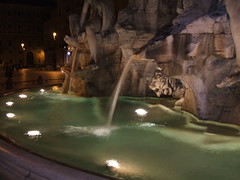
Piazza Navona is an extremely lively place with open air cafes around it. During the summer there are numerous artists who draw or paint members of the public for a fee. The place is crowded each day and there are often buskers and sometimes mimes to entertain. At Christmas time the piazza is filled with stalls selling figurines of all sizes and forms for cribs, so well into a frozen December night you can come here and see all the lights of the stalls and perhaps think about making your own crib. It's a child's delight. Fountain
Originally uploaded by socorro66.
Subscribe to:
Posts (Atom)



